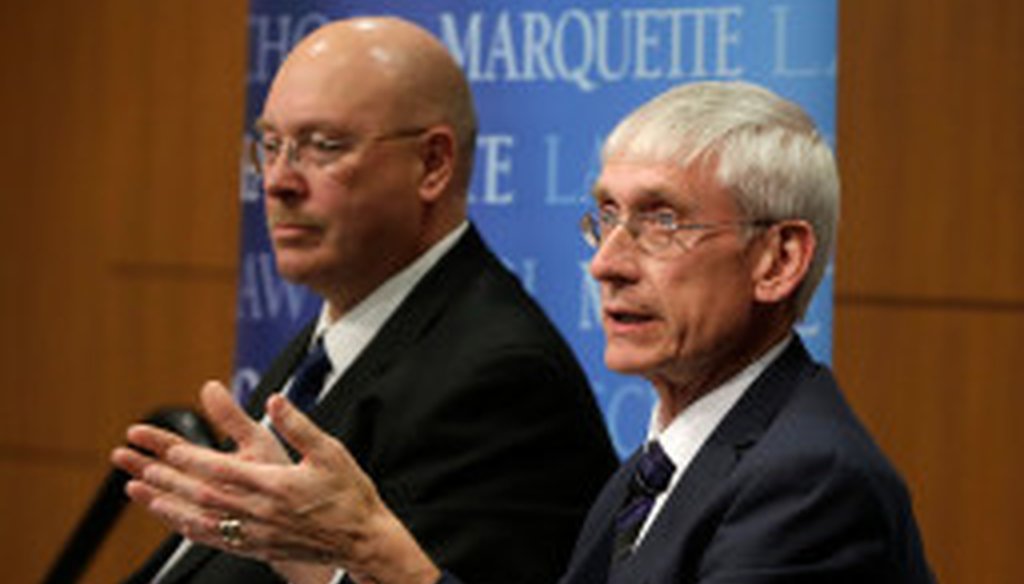



From left Lowell Holtz and Tony Evers, candidates for state superintendent of public instruction, discuss educational issues during a debate at Marquette Law School, Tuesday, March 28, 2017. Rick Wood MJS
At a campaign stop in northern Wisconsin, State Schools Superintendent Tony Evers addressed a hot topic: the declining supply of new teachers.
The trend "concerns me from the Northwoods point of view," Evers said, according to a WXPR public radio story that aired March 13, 2017.
He added that a University of Wisconsin-Madison study had found that among teachers looking for work, "less than 5% wanted to work in rural Wisconsin."
That’s bleak news for rural school districts -- if true.
Is it?
Behind the number
The Evers campaign told us the statistic came from research conducted by Peter Goff, a UW-Madison professor who is leading a team studying teacher supply and demand in Wisconsin.
Goff shared with us a draft version of the study, which is expected to be published soon by the Wisconsin Center for Education Research, headquartered on the campus.
Evers and other DPI officials were briefed on a preliminary, 2016 version of the findings.
The study by Goff and UW-Madison education graduation student Ellie M. Bruecker analyzed 194,495 applications for teaching vacancies in public school districts between January and October of 2014. The data came from a job-application website, the Wisconsin Education Career Access Network, and included those newly entering the profession as well as existing teachers.
Evers comment that "less than 5 percent wanted to work in rural Wisconsin" doesn’t square with the study’s findings.
Here are some key findings from the study:
-- 54 percent of prospective teachers did not apply for any vacancies in a rural school.
-- 40 percent applied to multiple types of districts, including rural ones.
-- Less than 5 percent applied only to rural vacancies.
That last conclusion reflects the claim made by Evers.
But if that fact is what he was thinking of, his claim didn’t accurately reflect the report.
Less than 5 percent of applicants applied exclusively to rural districts, but a total of 45 percent showed interest in rural vacancies.
Goff said there is clearly an aversion to rural districts for many applicants. Another piece of evidence for that: The average applicant submits only 15 percent of their applications to rural vacancies.
But, "applicant pools in rural districts don’t look any different than applicant pools in urban areas or towns," Goff told us. They have the same number of applicants, on average, with similar levels of experience, certification, advanced degrees and competitiveness of undergraduate institution.
Our rating
Evers claimed a study of where teachers apply to work found that "less than 5 percent wanted to work in rural Wisconsin."
The study found that schools in cities, suburbs or towns all draw more interest than rural districts, but Evers badly overstated the case.
We rate his claim False.
Tony Evers interview, WXPR public radio story aired March 13, 2017.
Interview with Thomas McCarthy, Department of Public Instruction spokesman, March 29, 2017
Interview with Amanda Brink, Evers campaign spokesperson, March 28, 2017
Interview with Peter Goff, professor, Educational Leadership & Policy Analysis, University of Wisconsin-Madison, March 29-30, 2017
Draft study, "The Role of Place: Labor Market Dynamics in Rural and Non-rural School Districts," Peter Goff and Ellie M. Bruecker, March 2017
Interview with Kimber Wilkerson, Professor, Acting Director of Teacher Education, School of Education, University of Wisconsin-Madison
In a world of wild talk and fake news, help us stand up for the facts.
